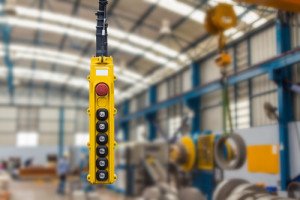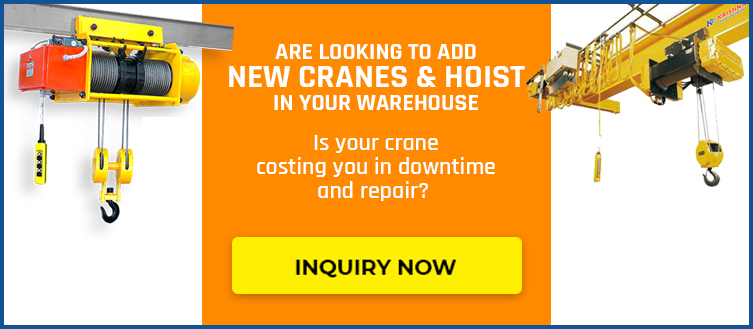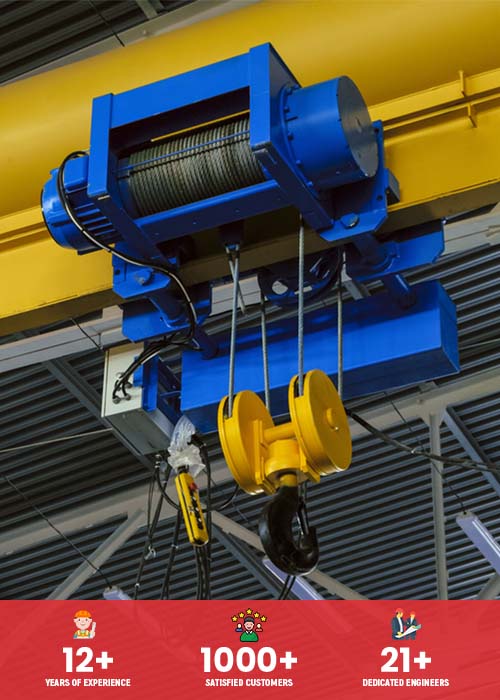Types of Electric Overhead Traveling Crane ( EOT Cranes Full Form )
Crane has been used as an important part of a working landscape since its invention. They are usually used in heavy lifting tasks and construction. There are different types of cranes available for different requirements. Each type of crane is crafted to meet the particular requirements of users. In this write-up, we will be seeing various types of EOT (Electric Overhead Traveling Crane) cranes that are available at the best EOT Cranes Manufacturer in Ahmedabad.
EOT Crane Full Form (Electric Overhead Traveling Crane)
There are various types of overhead cranes, industrial cranes & EOT Crane pdf with many being highly specialised, but the great majority of installations into one of three categories.
- Top running single girder bridge cranes,
- Top running double girder bridge cranes and
- Under-running single girder bridge cranes. Electric Overhead Traveling
What are the different types of cranes?
EOT Cranes

EOT Crane stands for Electric Overhead travelling cranes. This is the most commonly preferred EOT crane that is usually used in load lifting and shifting. They have the parallel runways and the gap is spanned by a travelling bridge. The hoist is mounted on this bridge. These cranes can be operated electrically.
Single girder cranes

The crane consists of a single bridge girder supported on two end trucks. It has a trolley hoist mechanism that runs on the bottom flange of the bridge girder.
Single Girder Cranes are the ones that are used in work units where heavy materials required either shifting or lifting. These cranes are solely used for maintenance and manufacturing purpose. The primary purpose of these cranes is to move heavy materials quickly and conveniently. These cranes offer high durability and can perform very well.
Double Girder Cranes

These are the cranes that have a capacity of 2 to 50 MT. Double Girder cranes can be used all heavy lifting purposes. The hook of these cranes can be lifted up to greater heights when compared to the single girder cranes. These cranes can be used in both interiors and exteriors. This is one of the added advantages of this type of cranes.
Jib Cranes

The Jib Cranes are a budget-friendly option and they will serve you in various ways. These robust cranes are capable of lifting heavy weights with ease. They have a broader reach and can cater to different kind of requirements.
Girder Bridge Cranes
The crane consists of two bridge girders supported on two end trucks. The trolley runs on rails on the top of the bridge girders.
Hot Crane

The hot cranes are ideally designed to use in factories where lifting and shifting of heavy material are carried on. They are not used in construction sites. These cranes are used to handle metal manufacturing process. From refining to dispatching the metal, these hot cranes takes care of the entire work.
Gantry Cranes

The Gantry cranes have a flexible and dynamic design with staunch moving ability. They can be used to carry heavy weighted goods from one place to another with the utmost convenience.
These cranes are essentially the same as the regular overhead cranes except that the bridge for carrying the trolley or trolleys is rigidly supported on two or more legs running on fixed rails or another runway. These “legs” eliminate the supporting runway and column system and connect to end trucks which run on a rail either embedded in or laid on top of, the floor.
Monorail
For some applications such as production assembly line or service line, only a trolley hoist is required. The hoisting mechanism is similar to a single girder crane with a difference that the crane doesn’t have a movable bridge and the hoisting trolley runs on a fixed girder. Monorail beams are usually I-beams (tapered beam flanges).
What is the meaning of EOT Crane?
The Electric Overhead Travelling cranes are the most frequently used cranes in the construction places and in industries. These cranes are operated with the help of electricity and one can operate it either by control room attached to the crane or by a pendant. These cranes have the capacity to lift both heavy and lightweight goods.
Single Girder EOT Cranes Means
The single girder EOT cranes are lighter when compared to the double girder ones and they have only one main bridge. They are mostly used for short period work and they help in lifting light duty loads to be precise one can lift 1 to 20 ton of load with the help of single girder EOT cranes. They are manufactured in both top running and under running models.
Double Girder EOT Cranes Means
Double Girder EOT cranes are used to lift heavy weights. They are a cost-effective option when compared with single girder cranes and are capable of lifting heavier weights. They are compatible with wide pans. They have two main bridges and this makes it robust as well as sturdy in nature.
How does EOT crane work?
The EOT crane works by using electricity and it can be operated with the help of either the driver or the pendant (remote control). The crane is capable of lifting up to 500 tonnes with a span of 60 meters. The universal coupling mechanism is incorporated in these cranes to facilitate both installation and adjustment. The mechanism consists of only four active and driven wheels, if the weight that has to be lifted is more, the wheel pressure is reduced. The articulated frame device will distribute among the four wheels so that the weight doesn’t pressurize only a particular wheel.
Which Crane should you choose – Single Girder or Double Girder

A common misconception is that double girder cranes are more durable! Per the industry standards (CMMA/DIN/FEM), both single and double girder cranes are equally rigid, strong and durable. This is because single girder cranes use much stronger girders than double girder cranes. The difference between single and double girder cranes is an effective lifting height. Generally, double girder cranes provide better lifting height. Single girder cranes cost less in many ways, only one cross girder is required, a trolley is simpler, installation is quicker and runway beams cost less due to the lighter crane dead weight. The building costs are also lower.
However, not every crane can be a single girder crane. Generally, if the crane is more than 15 ton or the span is more than 30m, a double girder crane is a better solution. The advantages and limitations of Single / double girder cranes are as follows:
Single Girder Cranes Works
- Single girder bridge cranes generally have a maximum span between 20 and 50 feet with a maximum lift of 15-50 feet.
- They can handle 1-15 tonnes with bridge speeds approaching a maximum of 200 feet per minute (fpm), trolley speeds of approximately 100 fpm, and hoist speeds ranging from 10-60 fpm
- They are candidates for light to moderate service and are cost effective for use as a standby(infrequently used) crane.
- Single girder cranes reduce the total crane cost on crane components, runway structure andbuilding.
Double Girder Cranes Works
- Double girder cranes are faster, with maximum bridge speeds, trolley speeds and hoist speeds approaching 350 fpm, 150 fpm, and 60 fpm, respectively.
- They are useful cranes for a variety of usage levels ranging from infrequent, intermittent use to continuous severe service. They can lift up to 100 tons.
- These can be utilized at any capacity where extremely high hook lift is required because the hook can be pulled up between the girders.
- They are also highly suitable where the crane needs to be fitted with walkways, crane lights, cabs, magnet cable reels or other special equipment.
EOT CRANE CONFIGURATION
- Under Running (U/R)
- Top Running (T/R)
EOT Crane Working Principle
There are three working movements of EOT Crane- crane hook up and down lifting, trolley lateral movement and crane long travelling longitudinal motion.
The motor exhibits a driving force of the hoisting mechanism. This transmits the power to high-speed shaft end. The ring gear transmits the driving force and then with the help of pulleys and wire ropes the crane hook is driven up and down. Similarly, the half gear coupling, its joint and compensation shaft will help in rotating trolley wheels.
Under running cranes
Under Running or underslung cranes are distinguished by the fact that they are supported from the roof structure and run on the bottom flange of runway girders. Under running, cranes are typically available in standard capacities up to 10 tons (special configurations up to 25 tons and over 90 ft. spans). Underhung cranes offer excellent side approaches, close headroom and can be supported on runways hung from existing building members if adequate.
The Under Running Crane offers the following advantages:
- Very small trolley approach dimensions meaning maximum utilization of the building width and height.
- The possibility of using the existing ceiling girder for securing the crane track.
Following are some limitations to Under Running Cranes
- Hook Height – Due to Location of the runway beams, Hook Height is reduced
- Roof Load – The load being applied to the roof is greater than that of a top running crane
Lower Flange Loading of runway beams require careful sizing otherwise, you can peel the flanges off the beam.
Types of EOT cranes catalog
There are various models of EOT cranes available in the market. If you want to know more about these types of cranes, their specifications and decide which one among them is your right choice, just download the catalog. It has everything you want to know about EOT cranes.
Double Girder EOT Crane Catalog
Single Girder EOT Crane Catalog
Choosing the Right EOT Crane for Your Needs
Electric Overhead Traveling (EOT) cranes are a versatile and essential tool for various industrial applications. However, selecting the right EOT crane for your specific needs is crucial for maximizing efficiency and safety. This guide explores key factors to consider when making your choice:
1. Capacity:
- Determine the weight of the heaviest load you’ll be lifting and choose a crane with a capacity exceeding that weight for a safety buffer.
- EOT cranes come in various capacities, from handling light machinery to heavy industrial equipment.
2. Span:
- Measure the distance the crane needs to cover horizontally to ensure it can reach all designated lifting zones within your workspace.
- EOT cranes are available in different spans to accommodate various facility layouts.
3. Lift Height:
- Consider the maximum height you’ll need to lift loads.
- EOT cranes offer varying lift heights depending on the hoist design and runway configuration.
4. Duty Cycle:
- Evaluate how frequently you’ll be using the crane. This will help determine the appropriate duty class (light, medium, or heavy) for your crane.
- Choosing the right duty class ensures the crane can withstand the demands of your operation without premature wear and tear.
5. Single vs. Double Girder:
- Single Girder EOT Cranes: Ideal for lighter loads and offer a more cost-effective solution.
- Double Girder EOT Cranes: Provide superior stability and lifting capacity for heavier loads.
For a more detailed exploration of EOT crane types and specifications, consider downloading a comprehensive EOT Crane PDF guide. By carefully considering these factors and referring to EOT crane resources, you can make an informed decision and select the perfect EOT crane to optimize your lifting operations.
Exploring Specialized EOT Crane Designs
While standard EOT cranes offer great versatility, specific applications may require specialized designs. Here’s a glimpse into some unique EOT crane configurations:
- Top Running vs. Under Running Cranes:
- Top running cranes operate on elevated tracks, maximizing headroom.
- Under-running cranes travel beneath the runway, suitable for facilities with limited overhead space.
- Monorail Cranes:
- These cranes consist of a single beam suspended from a track, offering a space-saving solution for lighter loads.
- Stacker Cranes:
- Designed for automated storage and retrieval systems, these cranes efficiently move and stack materials in warehouses.
- Jib Cranes:
- Featuring a horizontal arm that extends from a support column, jib cranes offer lifting capabilities in a localized area.
By exploring these specialized options, you can find an EOT crane that caters to your specific lifting requirements and workspace limitations.
Can an EOT Crane Help Your Business? Explore the Benefits and Applications
EOT cranes offer a multitude of benefits that can significantly enhance your business operations:
- Improved Efficiency: EOT cranes streamline material handling, reduce manual labor, and accelerate production processes.
- Enhanced Safety: These cranes promote safe lifting practices by eliminating the risk of worker injuries associated with manual lifting.
- Increased Productivity: EOT cranes enable faster and more efficient load handling, leading to increased overall productivity.
- Versatility: With various configurations and capacities available, EOT cranes can be adapted to handle a wide range of lifting tasks.
- Cost Savings: EOT cranes can reduce labor costs associated with manual lifting and improve overall operational efficiency.
Applications:
EOT cranes are utilized across a vast array of industries, including:
- Manufacturing
- Warehousing
- Construction
- Automotive
- Power Generation
- Shipping & Marine
If your business involves frequent lifting and material handling, an EOT crane can be a game-changer, contributing to a safer, more efficient, and cost-effective work environment.
How Do EOT Cranes Work?
EOT cranes are electrically powered and run on a fixed overhead track system. They have three main motions:
- Longitudinal Motion – Moves the entire crane forward or backward along the runway beams.
- Lateral Motion – Moves the hoist (lifting mechanism) left or right along the bridge girder.
- Vertical Motion – Lifts or lowers loads using a wire rope or chain hoist.
The combination of these movements allows EOT cranes to precisely lift, shift, and place heavy loads with minimal human effort.
Benefits of EOT Cranes
Indian industries rely on EOT cranes for a reason! Here are some major benefits:
1. High Load Handling Capacity
EOT cranes can lift loads ranging from 1 ton to over 500 tons, making them suitable for both small-scale and heavy-duty applications.
2. Improves Workplace Safety
With advanced control systems, these cranes reduce the risk of accidents that manual handling can cause. Features like anti-collision sensors, overload protection, and emergency brakes ensure safe operations.
3. Cost-Effective & Labor Saving
Automation reduces the need for manual labor, cutting down costs. Studies show that industries using cranes improve material handling efficiency by up to 40% compared to traditional lifting methods.
4. Increased Productivity
In industries like steel, cement, and shipbuilding, EOT cranes speed up operations, allowing businesses to handle more work in less time. Faster lifting and movement translate to better production rates.
5. Customization for Different Industries
EOT cranes can be designed to suit specific industry needs, whether it’s for a steel plant, warehouse, power plant, or chemical industry.
Safety Tips for Operating EOT Cranes
Even though EOT cranes improve safety, improper handling can lead to serious accidents. Here are key safety precautions:
✔ Train Operators Regularly – Ensure that only certified personnel operate the crane.
✔ Check Load Limits – Never exceed the crane’s rated load capacity.
✔ Inspect Cables & Hooks – Look for signs of wear and tear before every operation.
✔ Use Proper Signals – Communication between the crane operator and ground workers should be clear.
✔ Emergency Stop Ready – Always test the emergency braking system before starting operations.
Did you know? More than 60% of crane-related accidents occur due to human error. Proper training and maintenance can prevent such incidents.
Maintenance Tips to Keep Your EOT Crane Running Smoothly
Regular maintenance ensures longer crane life and better performance. Here’s what you should do:✔ Lubricate Moving Parts – Prevents wear and tear on gears, pulleys, and ropes.
✔ Inspect Electrical Components – Ensure that motors, wiring, and control panels are functioning properly.
✔ Test Brakes & Limit Switches – Safety features must always be in top condition.
✔ Keep Tracks & Rails Clean – Dust, rust, and debris can affect smooth movement.
✔ Schedule Annual Servicing – A professional inspection helps detect minor issues before they turn into major failures.




